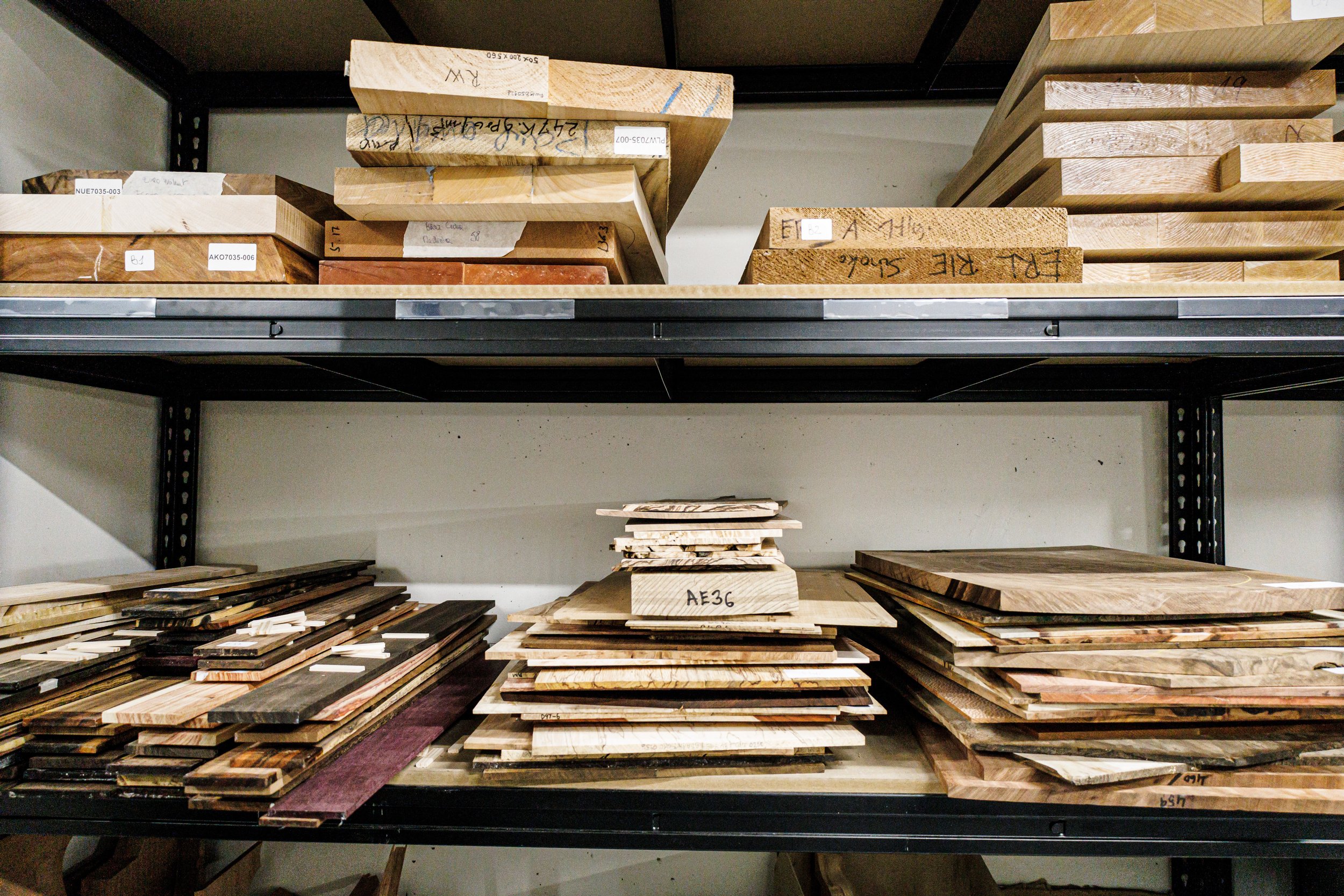(独一无二的收藏)
贝尔福帝®木材图书馆
了解 Belforti® 木材图书馆
我们的木头图书馆是一个独特的木头作品集,建立和组织在一个最先进的评级系统上,使用现有的最新技术和科学方法。
图书馆分为 3 个类别,基于以下几个因素,但最重要的是 Belforti Rating™(贝尔福特评级),它将不同的科学测量方法综合为一个独特的分数。
-
这些木材都是根据其音质和耐用性精心挑选的。它们提供了很好的音质平衡,并且具有最小的不规则性,很有美感。对于任何寻找可靠的、高质量的、有竞争力的价格的乐器的演奏者来说,它们是一个很好的选择。
所有特级木材的 Belforti Rating™ 评分都在 70 至 79 分之间。
-
大师级木材在视觉魅力和音质上更胜一筹。它们展示了更明显的身材和颜色,并有望产生卓越的音质丰富性和共鸣。它们因其完美的质量和独特的审美而被选中,使它们适合于专业音乐家和严肃的业余爱好者。
所有大师级木材的 Belforti Rating™ 评分都在 80-89 分之间。
-
最高品质的木材属于 "私人库存 "类别。这些木材通常专供定制商店和高端精品乐器使用。它们的特点通常是异常美丽、稀有和音色卓越。使用 "私藏 "木材制作的乐器是真正的艺术品,通常因其美观性和音乐性而被收藏。
所有私募股权投资基金在 Belforti Rating™ 中的得分都在 90 分及以上







在 Belforti Instruments®,我们深知世界森林的巨大价值,以及它们在乐器制作过程中所发挥的作用。因此,我们努力确保我们的木材采购行为尽可能负责任和符合道德标准。
起源、供应和道德规范
我们森林的起源
我们精心策划的木材库拥有来自全球各个角落的各种优质木材。我们选择的树种以其独特的音质、美学吸引力和工作特性而闻名。从美国桃花心木的丰富共鸣,到非洲黑檀的鲜艳色调,以及密歇根枫木的引人注目的美感,我们已经组建了一个系列,以满足各种音乐要求和个人审美偏好。
由于我们的产量非常小,我们允许自己使用外来物种,只要它们来自我们信任的可持续来源。我们的大部分香精都是在当地采购的,主要来自我们心爱的法国汝拉和孚日森林。
道德供应
我们对道德采购的承诺是毫不动摇的。我们与坚持最高环境标准的供应商紧密合作,他们与我们一样尊重世界森林。我们使用的木材来源合法,符合国际法律和法规,包括《濒危野生动植物种国际贸易公约》(CITES)和《雷斯法案》。
回馈社会
我们对自然界的敬畏超越了我们的木材采购做法。我们相信对环境的回馈,并为重新造林计划做出贡献。我们的目标是确保美丽音乐的创造不会以我们星球的健康为代价。
选择贝尔福迪乐器,您不仅投资于质量和工艺无与伦比的乐器,而且还支持一个重视道德和可持续发展的企业。我们可以一起创造出与自然和谐共鸣的音乐。
可持续发展
在贝尔福迪仪器公司,可持续发展是一个优先事项。我们认识到我们在为子孙后代保护世界森林方面的作用。因此,我们只允许在我们的商店里使用在管理良好、可持续发展的森林或家庭开采的木材。
我们的理念是,在很多情况下,比如马达加斯加,一个我曾经生活过并且深爱着的国家,有很多小型的家庭式开采,他们努力保护环境,确保他们与当地资源的未来。同时,隔壁经常存在一些不尊重可持续收获的保护准则的可疑的开发企业。如果我们选择抵制整个国家或物种,我们确实会解决一部分问题,但却不利于当地社区的潜在健康发展,如果他们的生意崩溃,可能会转向偷猎和黑市交易。
相反,我们与来自全球各地的小生产者、家族企业或合作企业密切合作。这样做使我们能够支持该行业的积极行动者,并向当地社区表明,正确的资源采掘方式在经济上和道德上都是更可行的。
此外,我们不断努力,通过充分利用每一块木材的潜力,在我们的制造过程中尽量减少浪费。
保存、干燥和老化过程
在贝尔福迪乐器公司,我们了解适当的老化和保存的木材在创造我们卓越的乐器中所发挥的重要作用。我们对质量和工艺的执着追求延伸到了我们对音色木材准备工作的细致入微和耐心。
-
我们桐木的旅程从保护开始。一旦树木被砍伐,我们就会采取措施,防止水分迅速流失,从而导致翘曲或开裂。这可能涉及到用蜡或类似物质封住木头的两端,以调节干燥过程。我们勤奋地保护木材的完整性,确保它保持其固有的美丽和共鸣的品质,这一承诺为我们其余的细致过程奠定了基础。
所有特级木材的 Belforti Rating™ 评分都在 70 至 79 分之间。
-
一旦得到适当的保护,木材就进入了干燥阶段。这个阶段通常是空气和窑炉干燥的混合,巧妙地平衡水分的自然流失和控制流失。空气干燥是减少水分含量的最温和的方法,可以持续几个月甚至几年。窑炉干燥是在严格控制的条件下进行的,以根除任何剩余的多余水分。这种双重干燥过程使我们能够达到与我们的乐器在整个生命周期中所经历的典型条件相一致的水分含量。
所有大师级木材的 Belforti Rating™ 评分都在 80-89 分之间。
-
我们木材准备过程的最后阶段是老化。随着木材的老化,它的音质特性会发生变化,通常会产生更丰富、更有共鸣的声音。在这段时间里,木材被小心翼翼地储存在受控条件下,以促进其缓慢调整和稳定。木材中的树脂会变硬,使乐器的反应更加灵敏,并增强其音色的复杂性。
在 Belforti Instruments®,我们坚信时间对音色的深刻影响。我们在每一块木材的制作过程中都投入了大量的时间和精力,这些都体现在我们乐器独特的音色和卓越的品质上。
所有私募股权投资基金在 Belforti Rating™ 中的得分都在 90 分及以上






贝尔福迪评级
Objective Tonewood Performance Analysis
Introduction - Bridging Scientific Measurement and Instrument Construction
The Belforti Rating System represents a groundbreaking approach to tonewood analysis, emerging from the critical need to transform instrument construction from an art of intuition to a science of precision. Inspired by Bryan Galloup's pioneering wood rating system for acoustic guitars, this methodology extends scientific material assessment to electric guitar construction.
Foundational Principles
Objective Material Characterization
Exclusive focus on measurable, quantifiable material properties
Elimination of subjective perception in material selection
Systematic approach to understanding wood's fundamental physical behaviors
Scientific Measurement Framework The system draws from multiple interdisciplinary research domains:
Materials Science
Acoustic Engineering
Vibration Analysis
Non-destructive Testing Methodologies
Comprehensive Analytical Parameters
1. BING (Beam Identification by Non-destructive Grading)
Developed by CIRAD Research Center, BING represents a breakthrough in material assessment. This vibration analysis technique provides critical insights into wood's mechanical properties through non-invasive testing.
Key Measurements:
Elasticity Modulus
Internal Friction Characteristics
Vibrational Response Patterns
Relevant Research:
Bucur, V. (2006). Acoustics of Wood. Springer Series in Wood Science.
Brémaud, I. (2012). Characterization of Wood Acoustical Properties. Journal of Non-Destructive Evaluation.
2. Detailed Material Property Analysis
2.1 Density Measurement
Methodology: Mass per unit volume determination
Significance: Directly impacts energy transfer, sustain, and vibrational characteristics
Measurement Technique: Hydrostatic weighing and volumetric displacement
2.2 Janka Hardness
Definition: Wood's resistance to wear and indentation
Testing Method: Steel ball indentation force measurement
Implications: Determines material durability and structural integrity
2.3 Modulus of Elasticity (Young's Modulus)
Quantification: Material's stiffness under applied force
Calculation: Stress-strain relationship analysis
Relevance: Predicts wood's flexural and vibrational potential
2.4 Modulus of Rupture
Measurement: Maximum stress before structural failure
Significance: Determines material's bending strength and structural limits
3. Advanced Analytical Techniques
3.1 FFT (Fast Fourier Transform) Analysis
Purpose: Transform vibrational signals between time and frequency domains
Outcome: Detailed spectral characteristic mapping
Applications:
Resonance potential identification
Vibrational energy transfer analysis
3.2 First Mode Frequency Determination
Definition: Primary resonant frequency of material sample
Measurement: Controlled excitation and frequency response analysis
Significance: Fundamental vibration characteristic indicator
4. Quantified Sustain Potential (QSP)
Innovative Composite Measurement
The QSP represents a breakthrough in material performance assessment, establishing a nuanced relationship between density and Quality Factor (Q-factor).
Key Characteristics:
Prioritizes density as primary performance indicator
Contextualizes Q-factor within density framework
Provides comprehensive material performance index
Calculation Methodology:
Measure raw density
Analyze Q-factor
Apply weighted algorithmic assessment
Generate composite performance score
Comparative Analysis:
High Q-factor in low-density wood: Limited performance potential
Average Q-factor in high-density wood: Superior performance characteristics
5. Rating System Mechanics
Scoring Methodology
Comprehensive rating on 100-point scale
Threshold for critical component usage: 70 points and above
Sub-70 point materials: Repurposed for secondary components
Tested Component Scope
Guitar bodies
Necks
Fretboards
6. Production Consistency Approach
System Capabilities
Material property retroengineering
Systematic wood grading
Comprehensive performance database development
Reproducible material characteristic mapping
Technological Foundations
Inspirational Sources:
Bryan Galloup's Acoustic Wood Rating System
CIRAD Research Center's Non-Destructive Testing Protocols
Advanced Materials Science Research
Comparative Research References
Brémaud, I. (2012). "Wood Acoustics and InstrumentMaking". Wood Science and Technology, 46(1-3), 1-24.
Bucur, V. (2006). Acoustics of Wood. Springer Series in Wood Science.
Wegst, U.G.K. (2006). "Wood for Sound". American Journal of Botany, 93(10), 1439-1448.
结论
Transforming Craftsmanship through Science
The Belforti Rating System represents more than a measurement technique—it's a paradigm shift in understanding material performance. By replacing intuition with precise, reproducible scientific methodology, we challenge traditional approaches to instrument construction.
Future Developments
Expanded material database
Machine learning integration for predictive modeling
Enhanced multi-parameter analysis techniques
Note: This system is a continuous evolution, representing our commitment to scientific precision in instrument manufacturing.


